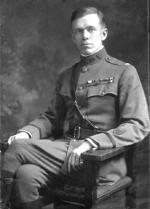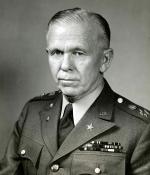![header=[Marker Text] body=[Soldier and statesman, born December 31, 1880, on this site. Chief of Staff, U. S. Army, 1939-45. General of the Army from Dec. 1944. Secretary of State, 1947-49, and Defense, 1950-51. Author of Marshall Plan for European recovery. Awarded the Nobel Peace Prize. Died Oct. 16, 1959.] sign](http://explorepahistory.com/kora/files/1/10/1-A-2DE-139-ExplorePAHistory-a0k4p4-a_450.jpg)
Mouse over for marker text
Name:
George C. Marshall
Region:
Laurel Highlands/Southern Alleghenies
County:
Fayette
Marker Location:
142 West Main Street (U.S. 40), Uniontown
Dedication Date:
January 17, 1981
Behind the Marker
"The noblest Roman of them all" was how Winston Churchill once described General George C. Marshall. Though Churchill and Marshall often disagreed on strategy during World War II, the prime minister respected the general who transformed the American army into an awesome fighting machine during his tenure as Chief of Staff from 1939-1945.
Born in Uniontown in 1880, Marshall entered the Army as a second lieutenant in 1902, served in the Phillipines, and then in a number of positions in the U.S. During World War I, his distinguished service on the General Staff, earned him the respect of General John J. Pershing, who, realizing Marshall's uncanny ability to plan large-scale military maneuvers, made Marshall his aide-de-camp. After the war, Marshall served in China and Illinois before accepting a post with the General Staff in Washington, D.C., in 1938. Almost six feet tall, with gray hair and intense blue eyes, Marshall exuded command and inspired the respect of his associates. "He is a tower of strength to us all," wrote an admiral in early 1941, as Marshall's plan for enlarging the army began to bear fruit.
As war clouds spread over Europe in 1939, President Franklin D. Roosevelt selected Marshall to be the new Army Chief of Staff. The outgoing Chief of Staff had recommended Marshall, even though he was ranked thirty-fourth on the army's seniority list. Marshall assumed his post on September 1, the day Hitler invaded Poland and ignited the Second World War. At the time, many Americans were strongly isolationist and wanted nothing to do with the troubles in Asia and Europe. But Marshall, among others, realized that if America would be drawn into the spreading conflict, her armed forces were woefully unprepared.
The army counted only 174,000 soldiers, ranking it nineteenth in the world, between Bulgaria and Portugal. Much of its equipment dated from World War I, and most of its officers had taken part in that conflict. Marshall had taught at Fort Benning for five years (1927-1932), where he had started to share his concepts of a modern, mobile war, something foreign to the World War I officers who had fought in static situations.
Now, as Chief of Staff, Marshall was in a position to do something positive to change America's army. He began to weed out those officers too old or incompetent to fight a modern war. Marshall had an uncanny ability to recognize good officers and kept a little black book that became feared throughout the army. In it, he listed those deserving of promotion and closely followed their careers as he pushed good officers into positions of more and more responsibility, rewarding those who succeeded and ruthlessly eliminating those who failed. He stressed simplicity in field orders so that they could be quickly written and executed.
Using others as leads to deflect hostile opinion from himself, Marshall managed to secure Congressional approval of a peacetime draft in 1940, renewed in 1941, to obtain manpower to enlarge the army. The general overhauled the training process so that recruits could learn necessary skills, developed officer candidate schools to find suitable officers from civilian ranks, and fought for more money to arm and equip the growing army, which reached 8.5 million by 1945. He also approved the development of a cadre system by which the older, established army divisions were used to form newer divisions with trained officers to lead them. Marshall also signed off on the "Victory Program," a document that accurately estimated the number of men and amount of armaments that would be necessary to win the war.
As Chief of Staff, Marshall worked closely with both President Franklin Delano Roosevelt and Secretary of War Henry Stimson. Although he disagreed with FDR on occasion, by 1943 Marshall and FDR worked more smoothly, and the president sided with Marshall to oppose the British strategy of defeating Germany by assaulting the fringe of the Nazi empire. (When Marshall had opposed the November 1942 amphibious landings in North Africa, but FDR had sided with the British, realizing that the use of American troops there would improve morale at home.)
FDR and Marshall were united in demanding a cross-channel invasion of France rather than fritter away troops in smaller operations that might not prove decisive. "Not one American soldier is going to die on [that] goddamn beach," said an irate Marshall to Churchill's insistence on an invasion of the island of Rhodes. In the end, Marshall and FDR got their way, and the Chief of Staff selected General Dwight D. Eisenhower to lead the American army in Europe.
Marshall's impact was felt in various other ways. Soon after Pearl Harbor, Hollywood director Frank Capra was ushered into Marshall's office, where Marshall sketched out for him his plan to have a series of films made to illustrate America's war aims. Under Capra's brilliant direction, the "Why We Fight" film series was an instant hit. The general also approved of the acquisition of the "jeep" in 1940 after it was recommended by one of his staff officers. Under his command, the American army became the symbol of victory in World War II. In 1945, Eisenhower wrote to his boss to say "You would be proud of the Army you have produced . . . you would be struck by the ‘veteran" quality of the whole organization."
"jeep" in 1940 after it was recommended by one of his staff officers. Under his command, the American army became the symbol of victory in World War II. In 1945, Eisenhower wrote to his boss to say "You would be proud of the Army you have produced . . . you would be struck by the ‘veteran" quality of the whole organization."
Following the end of World War II, Marshall acted as President Truman's special envoy to China, retired from active duty. As Secretary of State (1947-49), he became the spokesman for what became known as the Marshall Plan, the Truman administration's ambitious plans to rebuild western Europe. He later served as president of the American Red Cross and Secretary of Defense (1950-51). In 1953, he received the Nobel Peace Prize for his postwar work in Europe.
Born in Uniontown in 1880, Marshall entered the Army as a second lieutenant in 1902, served in the Phillipines, and then in a number of positions in the U.S. During World War I, his distinguished service on the General Staff, earned him the respect of General John J. Pershing, who, realizing Marshall's uncanny ability to plan large-scale military maneuvers, made Marshall his aide-de-camp. After the war, Marshall served in China and Illinois before accepting a post with the General Staff in Washington, D.C., in 1938. Almost six feet tall, with gray hair and intense blue eyes, Marshall exuded command and inspired the respect of his associates. "He is a tower of strength to us all," wrote an admiral in early 1941, as Marshall's plan for enlarging the army began to bear fruit.
As war clouds spread over Europe in 1939, President Franklin D. Roosevelt selected Marshall to be the new Army Chief of Staff. The outgoing Chief of Staff had recommended Marshall, even though he was ranked thirty-fourth on the army's seniority list. Marshall assumed his post on September 1, the day Hitler invaded Poland and ignited the Second World War. At the time, many Americans were strongly isolationist and wanted nothing to do with the troubles in Asia and Europe. But Marshall, among others, realized that if America would be drawn into the spreading conflict, her armed forces were woefully unprepared.
The army counted only 174,000 soldiers, ranking it nineteenth in the world, between Bulgaria and Portugal. Much of its equipment dated from World War I, and most of its officers had taken part in that conflict. Marshall had taught at Fort Benning for five years (1927-1932), where he had started to share his concepts of a modern, mobile war, something foreign to the World War I officers who had fought in static situations.
Now, as Chief of Staff, Marshall was in a position to do something positive to change America's army. He began to weed out those officers too old or incompetent to fight a modern war. Marshall had an uncanny ability to recognize good officers and kept a little black book that became feared throughout the army. In it, he listed those deserving of promotion and closely followed their careers as he pushed good officers into positions of more and more responsibility, rewarding those who succeeded and ruthlessly eliminating those who failed. He stressed simplicity in field orders so that they could be quickly written and executed.
Using others as leads to deflect hostile opinion from himself, Marshall managed to secure Congressional approval of a peacetime draft in 1940, renewed in 1941, to obtain manpower to enlarge the army. The general overhauled the training process so that recruits could learn necessary skills, developed officer candidate schools to find suitable officers from civilian ranks, and fought for more money to arm and equip the growing army, which reached 8.5 million by 1945. He also approved the development of a cadre system by which the older, established army divisions were used to form newer divisions with trained officers to lead them. Marshall also signed off on the "Victory Program," a document that accurately estimated the number of men and amount of armaments that would be necessary to win the war.
As Chief of Staff, Marshall worked closely with both President Franklin Delano Roosevelt and Secretary of War Henry Stimson. Although he disagreed with FDR on occasion, by 1943 Marshall and FDR worked more smoothly, and the president sided with Marshall to oppose the British strategy of defeating Germany by assaulting the fringe of the Nazi empire. (When Marshall had opposed the November 1942 amphibious landings in North Africa, but FDR had sided with the British, realizing that the use of American troops there would improve morale at home.)
FDR and Marshall were united in demanding a cross-channel invasion of France rather than fritter away troops in smaller operations that might not prove decisive. "Not one American soldier is going to die on [that] goddamn beach," said an irate Marshall to Churchill's insistence on an invasion of the island of Rhodes. In the end, Marshall and FDR got their way, and the Chief of Staff selected General Dwight D. Eisenhower to lead the American army in Europe.
Marshall's impact was felt in various other ways. Soon after Pearl Harbor, Hollywood director Frank Capra was ushered into Marshall's office, where Marshall sketched out for him his plan to have a series of films made to illustrate America's war aims. Under Capra's brilliant direction, the "Why We Fight" film series was an instant hit. The general also approved of the acquisition of the
Following the end of World War II, Marshall acted as President Truman's special envoy to China, retired from active duty. As Secretary of State (1947-49), he became the spokesman for what became known as the Marshall Plan, the Truman administration's ambitious plans to rebuild western Europe. He later served as president of the American Red Cross and Secretary of Defense (1950-51). In 1953, he received the Nobel Peace Prize for his postwar work in Europe.







